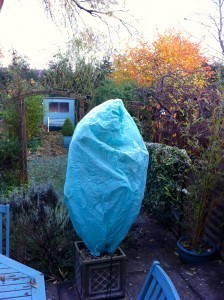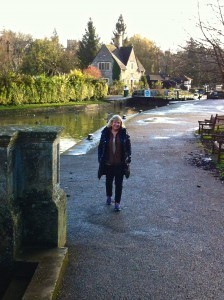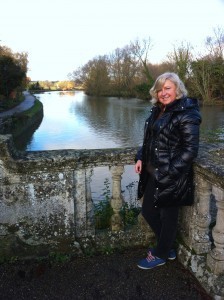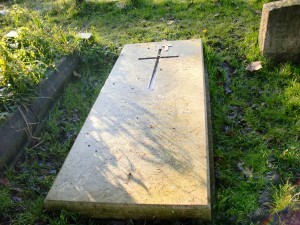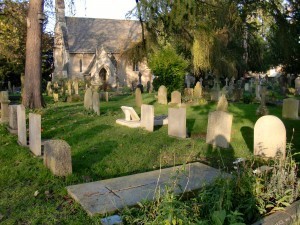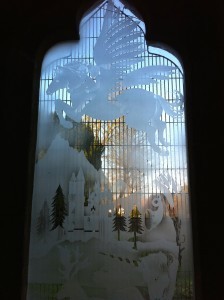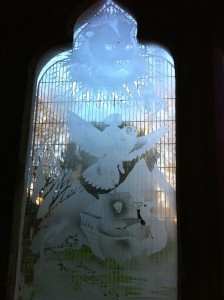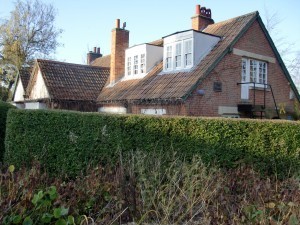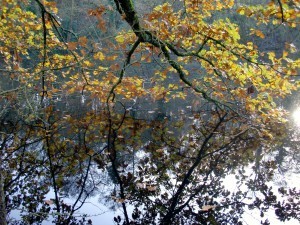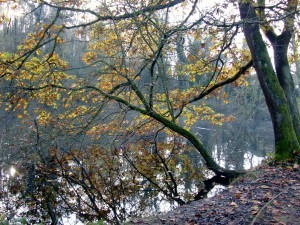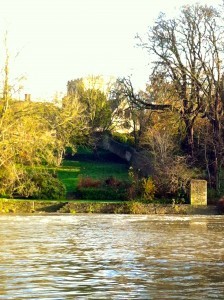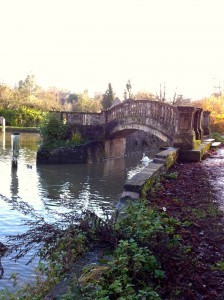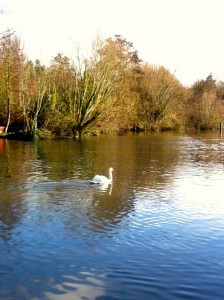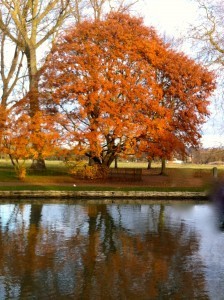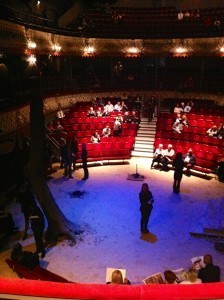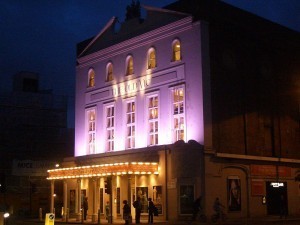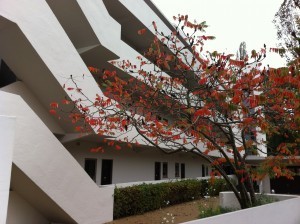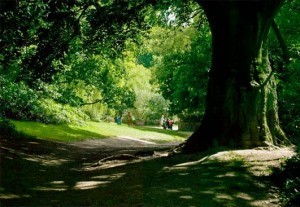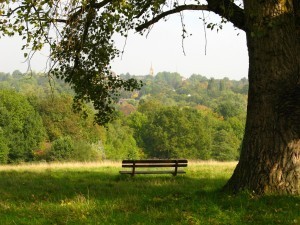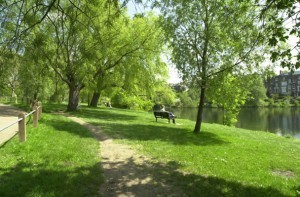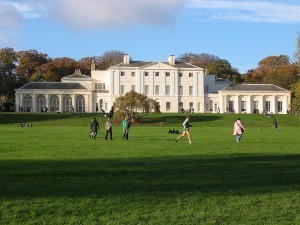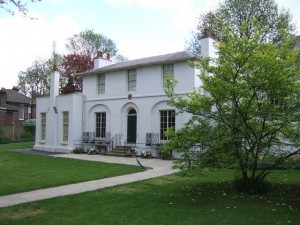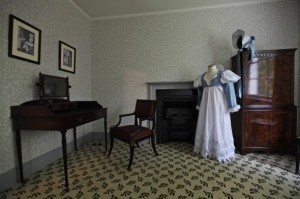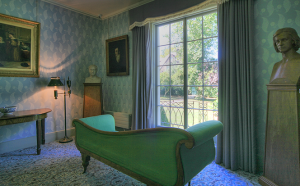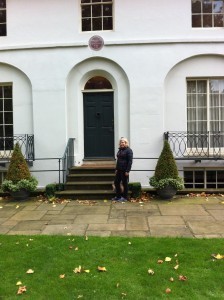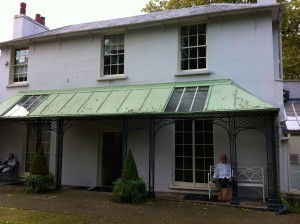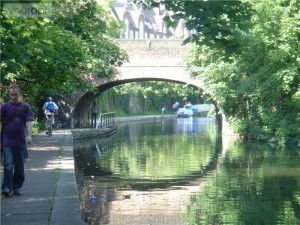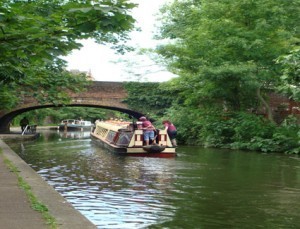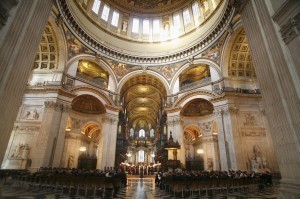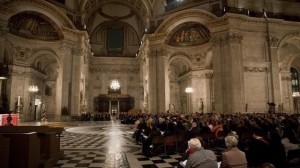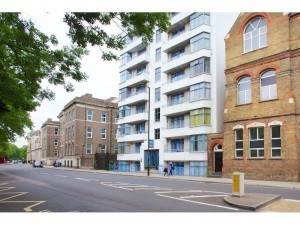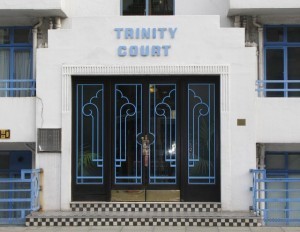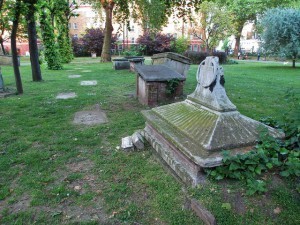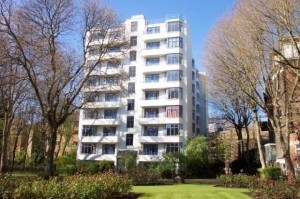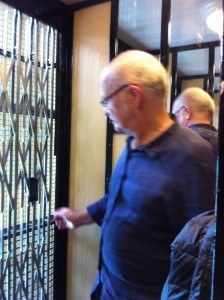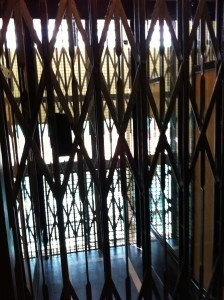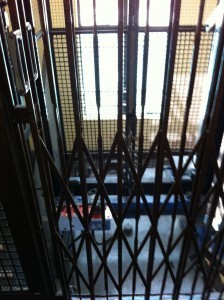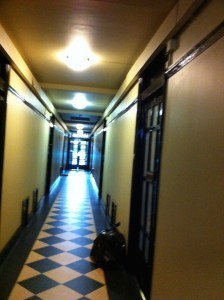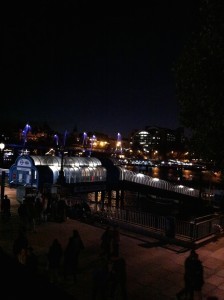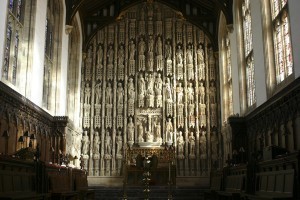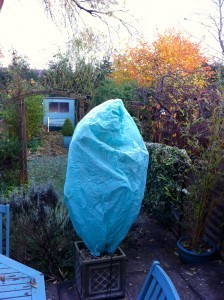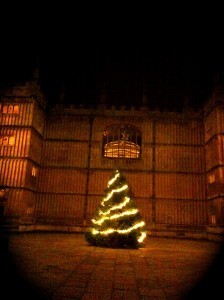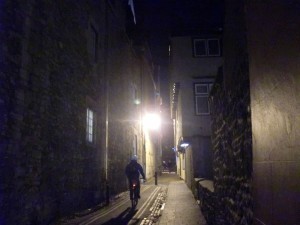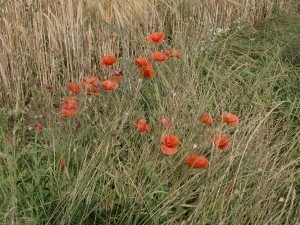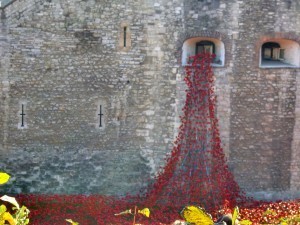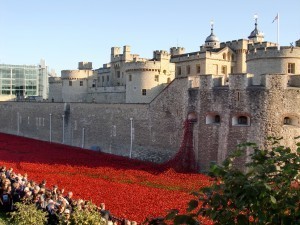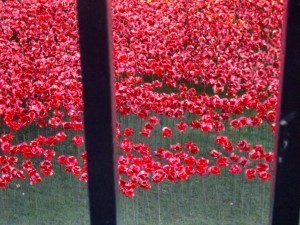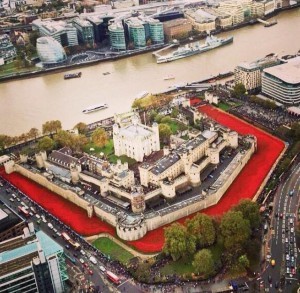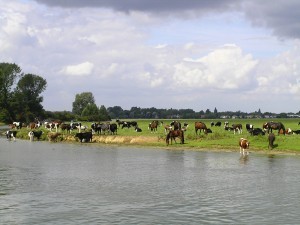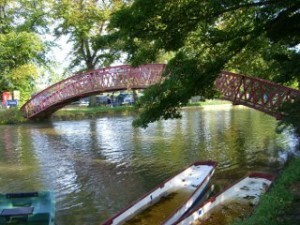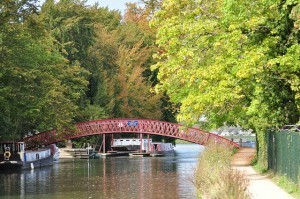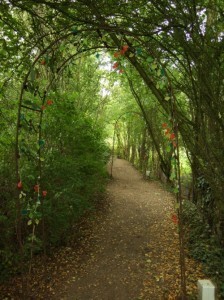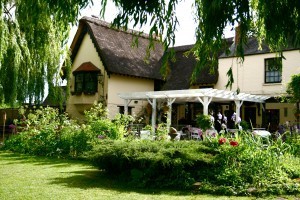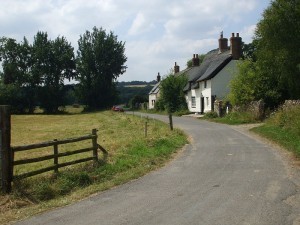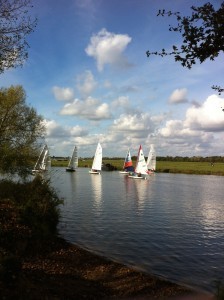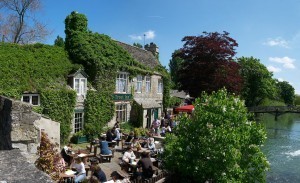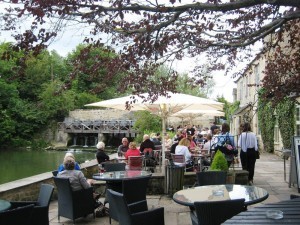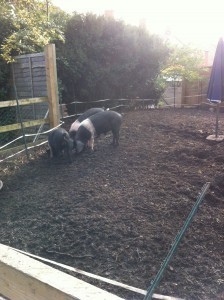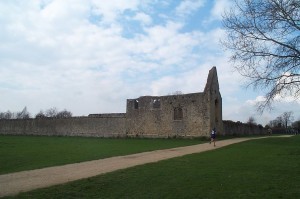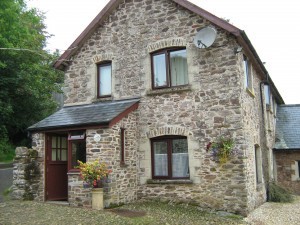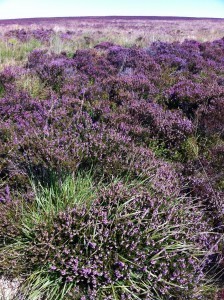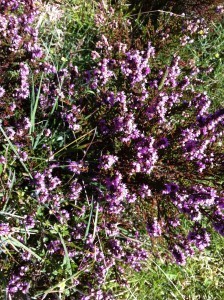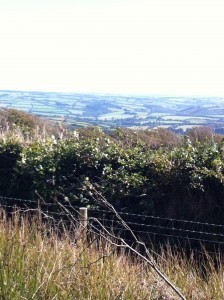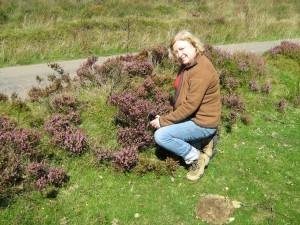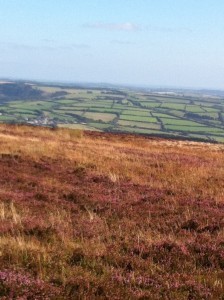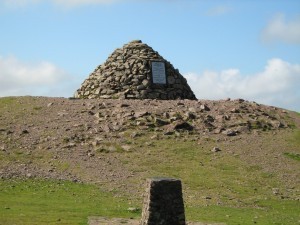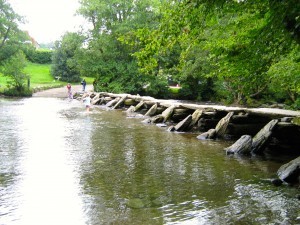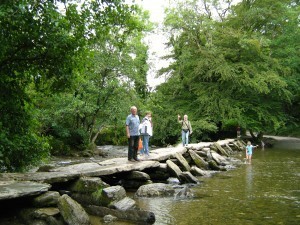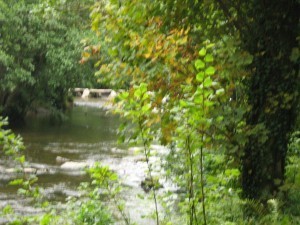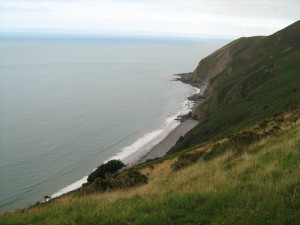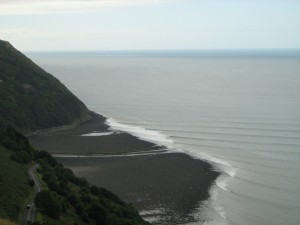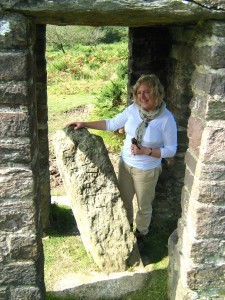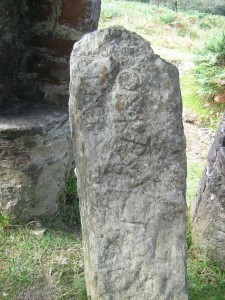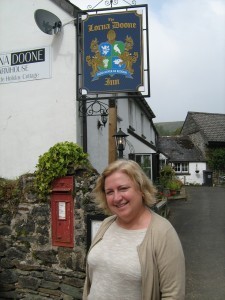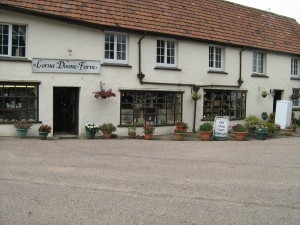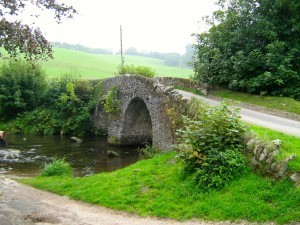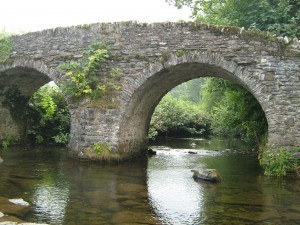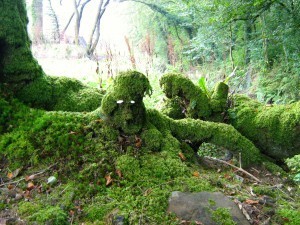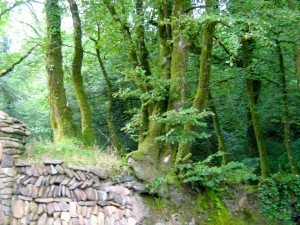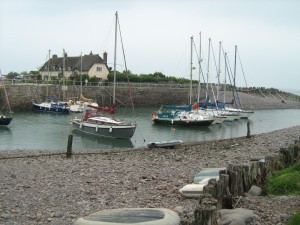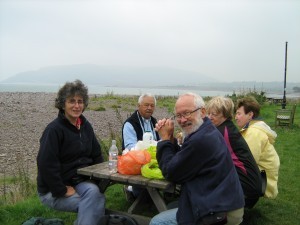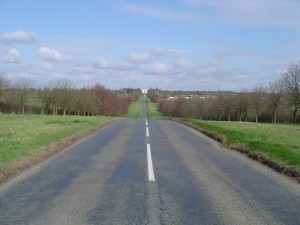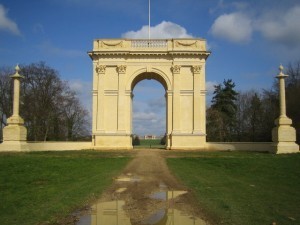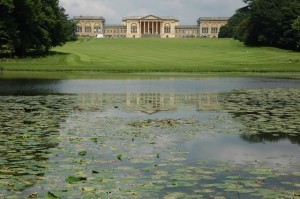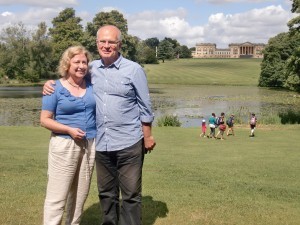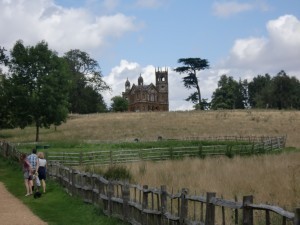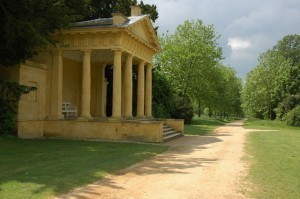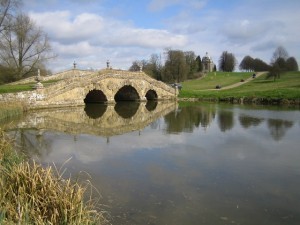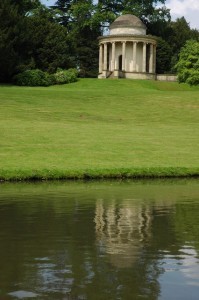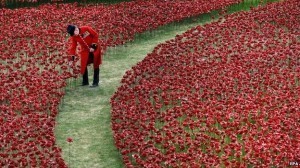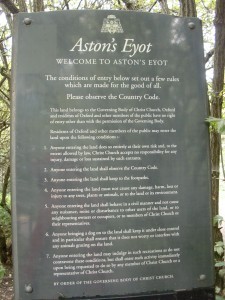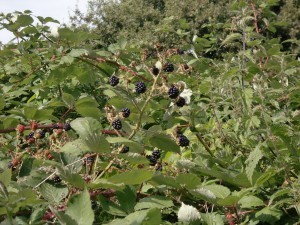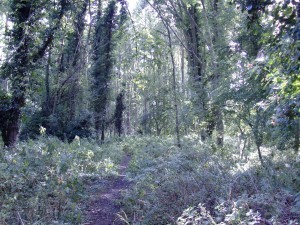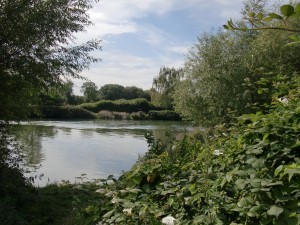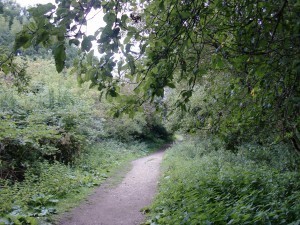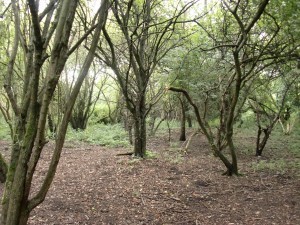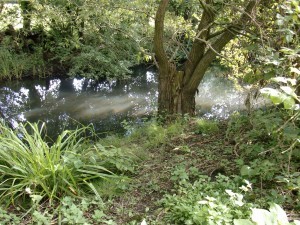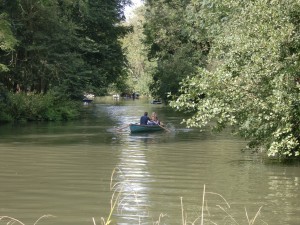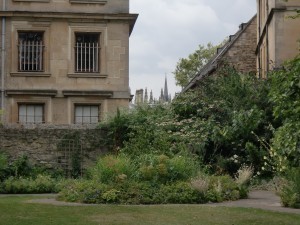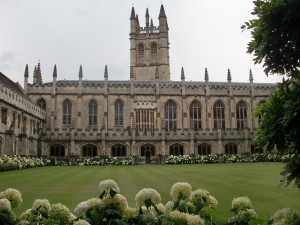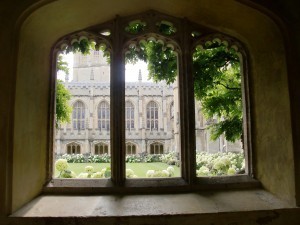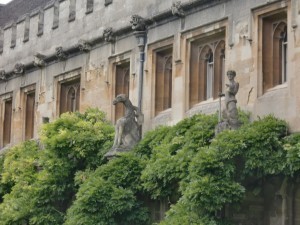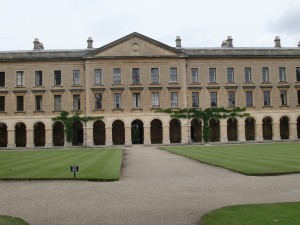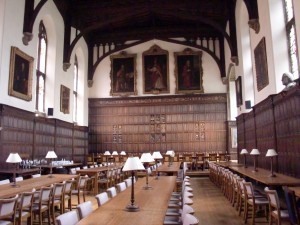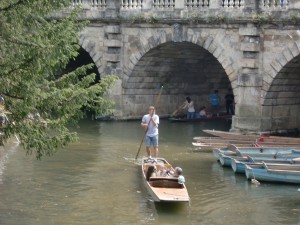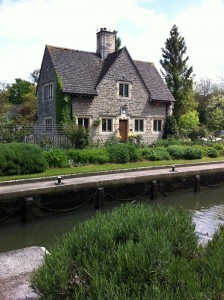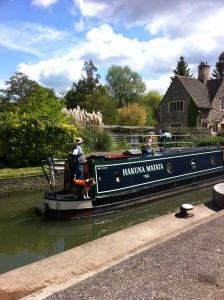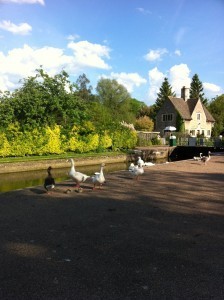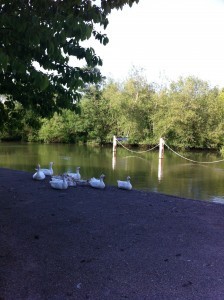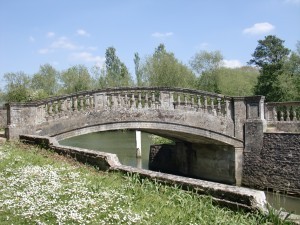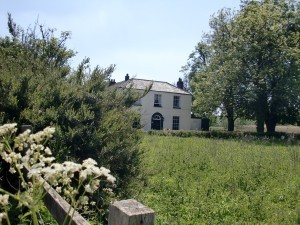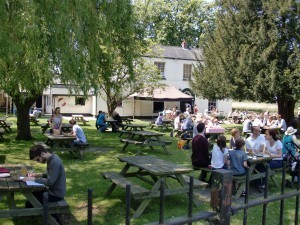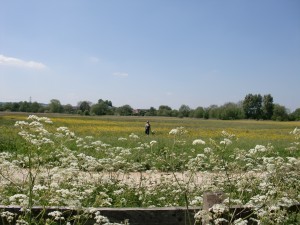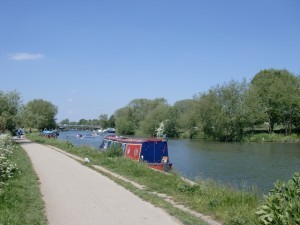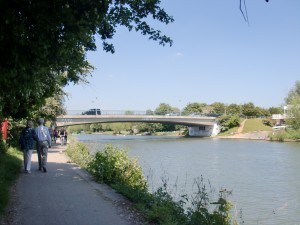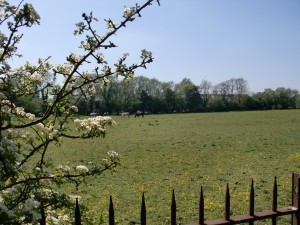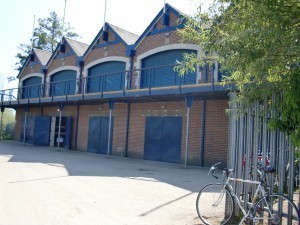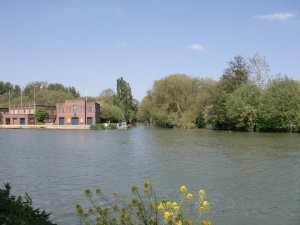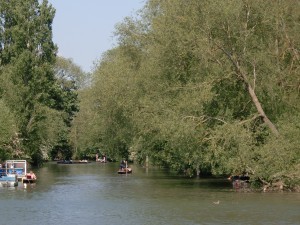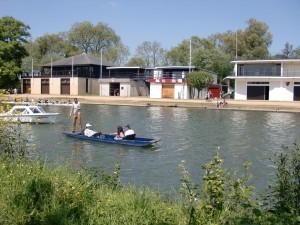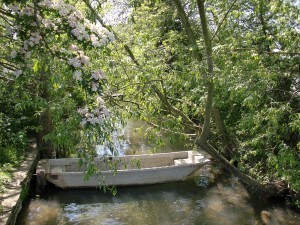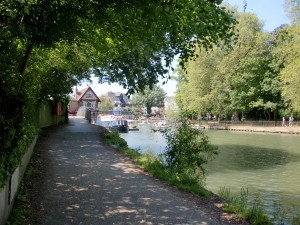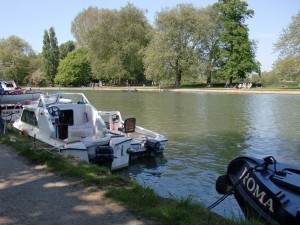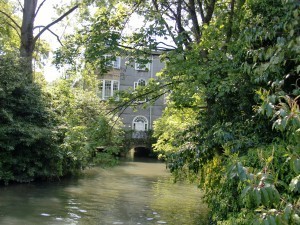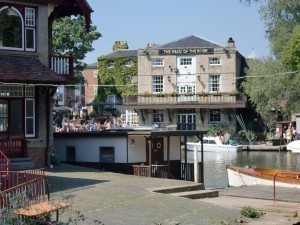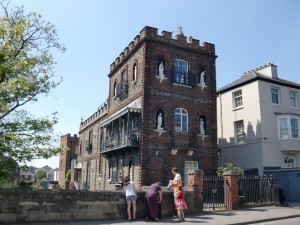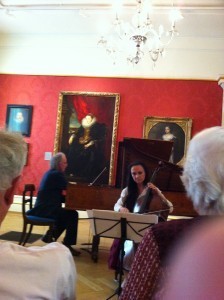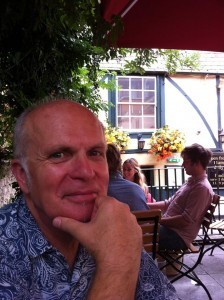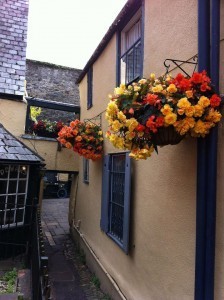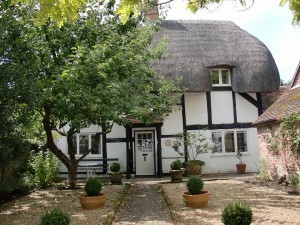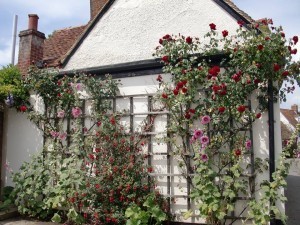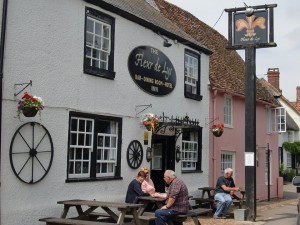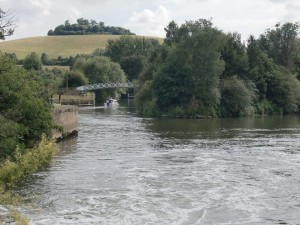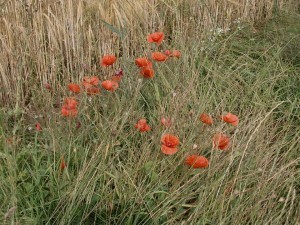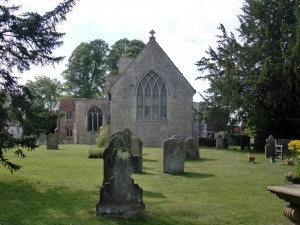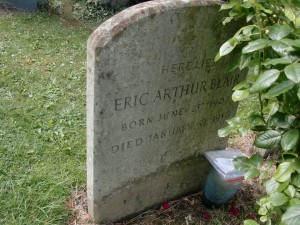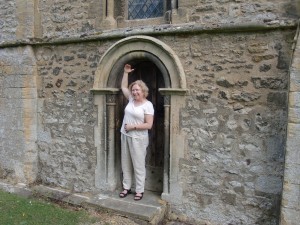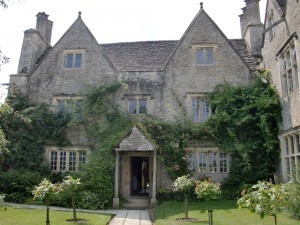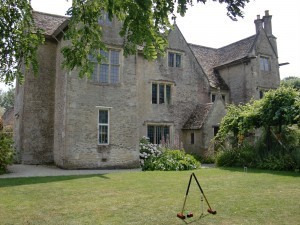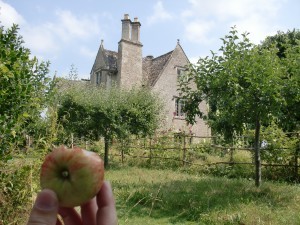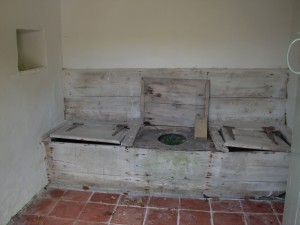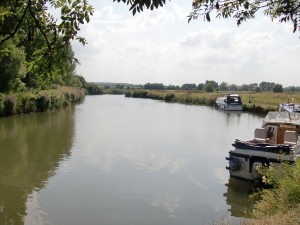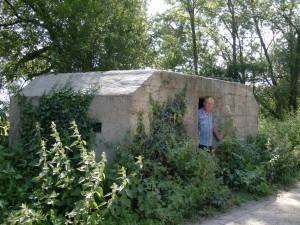Deborah Burrows's Blog, page 3
December 19, 2014
Winter in England
It’s certainly getting cold here. Next week we’ll have maximums of 5C and 7C. Our olive tree is rugged up against the frost:
Not to be outdone, I bought a down filled coat in New York and I tend to wear it whenever I go out.
A couple of weekends ago we drove out on a gloriously sunny day in search of C.S. Lewis and had an autumnal walk around Headington and Headington Quarry. We weren’t aware at the time, but the day of our walk – 29 November – was the 116th anniversary of Lewis’ birth.
He is buried in Holy Trinity Church.
Inside the nineteenth century church there is a a set of very sweet Narnia Windows.
His house, The Kilns, where he lived from 1930-1963 was nearby.
And just along the road was the CS Lewis Nature Reserve. Lewis used to own the land all around, including the nature reserve, but most of it was sold for housing after his death, unfortunately. Still, it is a very pretty little reserve. The trees were turning and the colours were gorgeous.
Then we had a very late lunch in a very trendy cafe in the Old Headington High Street, and raced the setting sun, to be home by 4.00.
We try to go for a walk once a day – actually, it’s hard not to go outside when the sun is shining and frost sparkles on the grass. The other day we went for a walk along the river – the Isis (or the Thames). What is fascinating to us as Australians are the changes to the view brought by the autumn leaf fall. Through the bare branches vistas open up that you never see in summer. For example, our lovely 12th century village church can now be seen from across the (rather swollen) river.
The Isis really is a picture in Autumn:
This oak, gloriously golden, is on the edge of Christ Church meadow.
In conclusion, we usually have a big Christmas tree, but this year we’ve moderated our expectations . . .
December 6, 2014
A Long Weekend in London
It’s beginning to get very chilly over here. At present (9.00am) it’s -2C, and we’re expecting a maximum of a balmy 6C. So my mind wanders back to happy times when it was still quite warm. In keeping with the rest of our poor earth, England had a very warm Autumn, and in October we took advantage of that to spend a lovely long weekend in Londong.
It’s about an hour and a half by bus from Oxford to London. Toby goes up to Town for the day about once a week, for his project. Sometime I join him, but it means keeping a watchful eye on the time and getting home very late indeed if we want to see a show.
So, in late October we took a holiday apartment near the Barbican for three nights. We’d booked to see Electra at the Old Vic on the Friday night and a concert at the Southbank Centre on the Sunday night. It was a marvellous long weekend in glorious London, despite me being rather ill with a chest infection/asthma.
Electra was excellent. A practically bare stage brought alive by wonderful actors, including Kristin Scott Thomas in the title role. The Telegraph described it as a ‘a kill-for-a-ticket triumph’. It’s a lot like Hamlet in story, only Electra is no princely Danish vacillator. She knows exactly what she wants – gruesome revenge visited upon her stepfather and mother for her father’s murder – and she succeeds in grisly fashion. Scott Thomas puts all of her undoubted talent into this tough, harrowing story of a daughter seeking vengeance.
And it was a delight simply to see a show in the Old Vic, which is located just south-east of Waterloo Station. It dates from 1818 and now sits alone in a busy intersection.
I’d said to Toby a while ago that I’d never been to Hampstead, and he’d read about an amazing set of flats called the Isokon Building that he thought we should see, so on the Saturday morning we took the bus out to Hampstead.
The Isokon Gallery is an exhibition in those modernist flats. The building was an important hub for those in the Bauhaus movement after they had been forced to leave Nazi controlled Europe. At Isokon they found refuge and means to survive. It was very modest but it meant life for them:
http://www.skandium.com/blog/archives...
It’s an amazing building with very pure lines:
The building was a haunt of Soviet spies. Interestingly, Agatha Christie lived there for some years in the Second World War. What is fascinating is that in 1941 she published her only spy novel, when she was living in one of the flats. Even more creepy is that in that novel – N or M? – one of the characters is called Major Bletchley. This at a time when Bletchley Park was the most secret place in Britain, as it was where the codebreakers were hard at work trying to decipher Enigma.
Writers pick up character names from anywhere they can. I read once, that in one of her books, Christie chose the names from a nearby graveyard. Names for characters are really hard to find; they have to fit the story and be memorable but not sound out of place. Had she overheard something in the flats, and as a result, had the name Betchley slipped into the ‘leaf mould of her mind’ to be resurrected as the name of a character in her new novel?
The blurb for N or M? is:
“The final words of a dying man … the code names of Hitler’s most dangerous agents …the elusive clue that sends that elegant detective team, Tommy and Tuppence Beresford, to a fashionable seaside resort on a mission of wartime intelligence. But not as husband and wife. As strangers, meeting by chance, setting an elaborate trap for an elusive killer.”
Then we wandered along to Hampstead Heath, that ancient London park (first recorded in 986). It amazes me that London has such enormous green spaces; Hamptstead Heath is only 6 km from Trafalgar Square, but it is a different world entirely: forested and rambling and hilly and utterly apart from the bustle of the city centre.
We wandered through the parkland past the Hampstead Ponds, three ponds in the Heath’s south-west corner. One of these is the ‘mixed pond’, where both sexes may swim, although we didn’t see anyone brave enough to try on that chilly morning.
I must admit that we got a bit lost in the wilds of Hampstead, but it gave me some indication of when the Heath was a dangerous place, full of footpads and highwaymen. Nowadays, on a fine(ish) Saturday morning, the heath is green and full of Londoners exercising their dogs. Toby swears he had a ‘celebrity spotting’ – of the man who plays Robbie in Taggart. I was away in my mind, imagining the Heath 200 years ago, and didn’t see him to verify the spotting.
Eventually we found our destination: Kenwood House.
It was of interest to me as a lawyer, as its most famous owner was the Chief Justice, Lord Mansfield, who bought it in 1754 and commissioned Robert Adam to remodel it from 1764–1779. Adam added the library, which is one of his most famous interiors:
Lord Iveagh, a wealthy Anglo-Irish businessman and philanthropist (fromthe Guinness family), bought the house from the Mansfield family in 1925. He left it to the nation upon his death in 1927 and it was opened to the public in 1928. The furnishings had already been sold by then, but some furniture has since been bought back, and the house has just reopened after major refurbishment. It is really lovely inside:
And it is full of priceless paintings from Lord Iveagh’s collection. We had lunch in the former stables and spent a few hours wandering around the house and admiring the paintings. This an Underground poster of it from the 1930s:
After tea in a pretty cafe, and stopping off to buy me a pretty pink coat, we went along to Keats’ house located, not surprisingly, in Keats Grove. John Keats lodged there with his friend Charles Brown from December 1818 to September 1820. These were perhaps Keats’s most productive years, and according to Brown, “Ode to a Nightingale” was written under a plum tree in the garden.
It is now a museum, with the rooms restored to some semblance of how they’d have been in Keats’ time:
Here I am at the doorway:
And here is Toby, round the back:
On the bus on the way back to the Barbican we saw a sign for the Grand Union Canal, and as we’d never been there, we got off our bus and went for a wander along the canal, into Little Venice and beyond.
On Sunday morning we attended the sung eucharist at St Paul’s Cathedral, which was within walking distance of our apartment. It was beautiful and moving, in a sublime setting.
After the service, I was inclined to look around. We saw a sign leading to the vaults, an open doorway and interesting looking stairs. So I charged on downwards with Toby behind me. ‘This isn’t open,’ said a voice as we started to explore the subterranean areas. A verger in a black cassock had run to catch us up. We said our apologies, and he relaxed and said he’d take us through the vaults to the exit. As we were walking, discussing cricket, as this was his main interest in Australia, a door opened, and he asked us to stand back. Out poured the boys’ choir, now dressed in ‘civvies’. They’d sung like angels upstairs and were now jostling and chattering and acting like entirely normal, lively, mischievous little boys.
We lunched in the Cathedral cafe, and then we went for a walk around Bloomsbury, where my next novel is set. I wanted to walk the streets my heroine walked and see the area where she lives. I’d put her into a flat in a lovely Art Deco apartment block in Grays Inn Road, called Trinity Court. So we wandered from where her Ambulance station was located in 1940 – on the corner of Woburn Place, past Russell Square Gardens, up Guildford Street, past Corams Fields, to turn into Grays Inn Road. And there, towering over the Georgian houses around in stark white Art Deco magnificence was Trinity Court.
It sits on the site of an old church, St Andrews, which was demolished in the 1870s. The church’s graveyard is now a park behind the flats, St Andrews Gardens:
Even better, when I poked my head into the lobby, a voice sung out from the basement (caretaker’s) flat. ‘What do you want?’ I replied, ‘Oh, we were just having a look around. It’s such a lovely building.’ His reply, ‘Look all you like. Take the lift if you want.’
And we did! It still has it’s 1930s cage lift and we rode it to the top and wandered around the hallways.
How amazing is that!! Now I have a real feel for where Lily is living. And we also wandered along Piccadilly, as Lily has dinner at The Ritz and sees out an air raid in the luxurious security of that hotel.
That evening we took the bus to Southbank and ate chicken burritos from the Mexican Street Kitchen while sitting in deckchairs and watching the lights over the Thames.
We were at Southbank because we’d booked to see the Smoke Fairies and Leisure Society in concert at the Queen Elizabeth Hall. It was a really fun concert and we had a great time.
Back to Oxford the next day, but not to rest. To top it all off, on Monday night in Oxford, we went by invitation to the chapel of All Souls College to hear poetry and early music in amazing surroundings.
Just a usual long weekend over here…
November 24, 2014
First pages done, and Winter is Coming…
Winter is coming…
We had our first frost last night and this morning the car windows were frozen. At the request of Gail, our landlady, Toby shrouded the olive tree in our back garden. Poor thing looks rather desolate now (the tree, not Toby!):
But if winter is coming, so is Christmas. The lights are up in Oxford and we saw the Christmas Tree at the Old Bodleian as we walked home the other evening:
There have been no blog updates for a while because we travelled to America (blog post to follow) and I’ve been so busy going through the manuscript for A Time of Secrets and making sure it’s exactly what I want to be published. The process for producing a book is time-consuming and sometimes frustrating. Pan Macmillan Australia put a lot of effort into ensuring that the book is the best that it can be, and expect me to do the same.
When the book is released it will have been reviewed by three professional editors from Pan Macmillan Australia (who don’t make changes, but simply point out plot inconsistencies and word or phrasing overuse etc), me and Toby. What is amazing that in this final edit Toby still found typographical errors, and I’m almost certain that the professional copy-editor (engaged by Pan Macmillan) who is considering it now will find some also!
Over the past month I was busy completing the final edit – known as First Pages. It’s the first time an author is able to see what the finished book will actually look like. And wow! It looks gorgeous. Only then I had to go through those pages backwards and forwards, chapter by chapter, making sure that the words were exactly as I wanted them to be, weighing each sentence for readability and sense, finding any mistakes and making those last minute tweaks to wording or plot.
As i said on my Facebook page, the first word is ‘You’ and the last is ‘Melbourne’. This is a very Melbourne-centred book, although my characters hail from all over Australia. The main protagonist, Stella Aldridge, is English, but she spent a lot of her life in Asia and the previous six years in Sydney. My to main male protagonists are from Perth (well, Eric was born in Wyalkatchem). In World War 2 many young people moved around Australia when they joined the services, and of course the men then were often transferred overseas. Stella is in the Australian Women’s Army Service and has been transferred from Sydney to Melbourne. I read many accounts of young women who left home for the first time, to join the AWAS, or the WAAAS, or the WRANS, or the Land Army or the nursing service, and who had adventures and romance as a result. And I spoke to women who had those experiences.
Anyway, the edits are now complete and I’m told that the proofread will be back later this week. So, next week Pan Mac will send me any outstanding questions about the book. Once that final check is complete the manuscript will be sent for printing. I’ll get a proof copy in January. It’ll be on the shelves in mid-February, although it’s a March release.
But, it hasn’t been all work. Last Monday Toby and I went to lovely Merton College to attend a symposium on Tolkein in Oxford. It was very enjoyable indeed
http://www.merton.ox.ac.uk/event/tolk...
We wandered back afterwards along Magpie Lane and had dinner in a cafe in Turl Street.
Here is pretty Magpie Lane:
And this is Turl Street, crowded with students on a chilly evening:
I’ll try to update more regularly now that the editing is almost complete. Although, now I’m back to writing…
November 12, 2014
On Flanders fields . . . and in the Tower of London
In Flanders fields the poppies blow
Between the crosses, row on row,
That mark our place; and in the sky
The larks, still bravely singing, fly
Scarce heard amid the guns below.
We are the Dead. Short days ago
We lived, felt dawn, saw sunset glow,
Loved and were loved, and now we lie
In Flanders fields.
Take up our quarrel with the foe:
To you from failing hands we throw
The torch; be yours to hold it high.
If ye break faith with us who die
We shall not sleep, though poppies grow
In Flanders fields.
by John McCrae, May 1915
World War I has been on everybody’s minds here as the centenary of the start of that terrible war came closer. Toby and I were in America on Remembrance Sunday (and I’ll talk about that trip in another post) and we returned on Monday 10 November after an overnight flight in which I got no sleep. Because of that I slept in on Tuesday 11 November, until 11.00am. So I suppose I kept a minute’s silence, but it wasn’t what I’d wanted to do. I usually try to spend the minute remembering the dead, and the survivors, of that war.
The British seem to view Armistice Day the way we in Australia view Anzac Day. Newsreaders, politicians, celebrities have all been wearing poppies on their jackets and dresses for weeks leading up to the day. And poppies are such a wonderful image of death and of beauty. They grow wild in the fields here in England, too, and whenever I see them I think of the first stanzas of McCrae’s poem. Like too many others, John McCrae didn’t survive the war.
The story behind the poppies as an enduring symbol of WW1 is interesting. The Flanders poppy is a weed that thrives best in soil that has been disturbed, and there is little more disturbed than a battlefield. Between 1914 and 1918, Flanders became one of the most devastated regions of the entire battlefield. Yet many soldiers noticed, in Flanders and in other regions of the front, that poppies grew, and the flowers added a haunting dash of colour to the trenches. The poets among the soldiers wrote about the splashes of red, like blood, that had sprung up in the devastated ground where men had fallen.
One of the most amazing commemorations of the centenary of the outbreak of WW1 is the installation at the Tower of London, “Blood Swept Lands and Seas of Red.” It uses the poppy image to create an extraordinary and intensely moving memorial to the British and Commonwealth war dead of WW1. 888,246 ceramic poppies have been planted in the Tower’s moat, each poppy representing a British and Commonwealth military fatality during WW1. They spill down from the tower like soldiers going ‘over the top’ and they fill the moat with a luminous red. The last ceramic poppies were ‘planted’ on 11 November, Armistice Day. It is an ephemeral exhibition and today, on 12 November, it will begin to be dismantled.
These are photos I took when we went to the exhibition on 27 October. It was incomplete, but still amazing:
It is estimated that more than four million people have visited the Tower to view the poppies. Certainly, when Toby and I went, the sheer numbers of people around us were staggering. And, from their accents, it was not tourists but mainly Brits who had come to see this very moving commemoration.
The title of the poppy installation is not from John McCrae’s poem, but from the first line of a poem written by an unknown soldier who is believed to have perished in Flanders:
The blood swept lands and seas of red
Where angels dare to tread.
I’ve pinched this photo from Michael Vaughn’s facebook page. It shows the moat filled with the poppies on 11 November.
The ceramic poppies are, as I write, being taken down by 8,000 volunteers to be cleaned and sent out to people who have bought them.
We bought 3, to represent the 3 members of our families who fell in the Great War. Reginald Benton of the Lancashire Fusiliers was Toby’s father’s mother’s older brother; he died on the Western Front in 1916. Sergeant Clegg, Toby’s uncle by marriage, was part of the British forces at Gallipoli and died in August 1915.
The third poppy is for my great-uncle, George Douglas Eastwood, who was my mother’s father’s younger brother. Like my grandfather, he was English, but joined the AIF in Sydney as he was on holiday in Australia when war broke out. He fell at Gallipoli, fighting with the Anzacs.
Name: George Douglas Eastwood
Service Number: 280
Rank: Private
Unit: 18th Australian Infantry Battalion
Date of death: 27 August 1915
Place of death: Gallipoli, Ottoman Empire
Cause of death: Killed in action
Age at death: 26
Place of association: Sydney, Australia
Cemetery or memorial details: Hill 60 Cemetery, Gallipoli Peninsula, Canakkale Province, Turkey
Source: AWM145 Roll of Honour cards, 1914-1918 War, Army
Some people have denigrated the poppy installation as being too pretty and as glorifying war, but from the conversations I heard around me when we visited, people ‘got’ what it was supposed to mean.
‘Each of those flowers represents one life,’ a man standing near me told his son, who looked to be around ten. ‘Look how many there are. Just think about that, each one represents one life. Now, you remember this. It’s very special.’
And it is very special. Importantly, all you can do is look and try to envision each poppy representing an individual with a life and a unique story. In many ways, it’s a lonely exhibition because of the anonymity of the flowers. There are no names for those the poppies represent – the emotive power comes from the sheer enormity of the numbers of flowers. So we, and the people around us stood, and looked, and pondered, many out loud, about the terrible cost of war. And there were many comments about how little we have learned since then.
The poppies represent only the British and Commonwealth soldiers who died in World War 1. If we planted a poppy for every life lost in that war, the tide of red would flow out of the moat and along the streets of London for miles, because the total number of deaths in World War 1 includes about 10 million military personnel and about 7 million civilians.
One British actress has suggested that the installation is too beautiful and the entire display should be wrecked. She’d like a tank to mow down the poppies and leave them ‘shattered and broken like the bodies of the guys that died.’
I disagree strongly. Why kill them over again? No-one who fought in that war is alive now – all the soldiers have died, together with most of the civilians who saw the carnage. Leave the dead in peace. The poppies will be removed and the moat will fill with grass again, just like the grass covers Flanders fields each year, when the poppies cease to bloom.
One of my favourite ‘war’ poems is this one by Carl Sandberg:
Pile the bodies high at Austerlitz and Waterloo.
Shovel them under and let me work—
I am the grass; I cover all.
And pile them high at Gettysburg
And pile them high at Ypres and Verdun.
Shovel them under and let me work.
Two years, ten years, and passengers ask the conductor:
What place is this?
Where are we now?
I am the grass.
Let me work.
October 6, 2014
A Sunday stroll
In England you have to take good weather and really enjoy it, because it’s unlikely to last. Yesterday was a glorious autumn day, sunny and still. There was a hint of coolness in the air but it was warm in the sunshine. So we decided to take the bus into Oxford and walk north, out to Godstow and the Trout Inn, because I had such happy memories of it from my time in Oxford 14 years ago. I knew that it would be packed on a sunny afternoon, so we thought we’d have lunch at the Perch Inn at Binsey and then walk on to Godstow and the Trout.
One benefit of the trip was that we got to walk through Jericho, the ‘fun’ bit of Oxford. As Wiki says:
“Jericho is a historic suburb of the English city of Oxford. It consists of the streets bounded by the Oxford Canal, Worcester College, Walton Street and Walton Well Road. Located outside the old city wall, it was originally a place for travellers to rest if they had reached the city after the gates had closed. The name Jericho may have been adopted to signify this ‘remote place’ outside the wall.”
From Walton Well Road we crossed Portmeadow, that flat wasteland to the north of Oxford where animals graze. It floods each year and is a little bit of wilderness near the city. The cows walked into the river and the scene was bucolic.
You cross the river at the Rainbow Bridge, built in the 1870s by public subscription:
And then you join the Thames Path. It was crowded with walkers, cyclers and runners, enjoying what might be the last sunny Sunday until Spring.
Our first stop was for a ‘roast Sunday lunch’ at the Perch at Binsey. The Perch is a lovely pub – much improved from my last visit, mainly because it had been extensively damaged by fire in 2007 and rebuilt. It dates back 800 years, and the current building to at least the 17th century. Apparently, it’s haunted by a sailor, but I didn’t see him.
The Perch, together with most of the other buildings in Binsey, is owned by Christ Church College in Oxford. Lewis Carroll was often seen there, and it was one of the first places that he gave public readings of Alice in Wonderland. It was also a favorite of C. S. Lewis and – of course! – Inspector Morse. The entrance is through a sylvan path
into the garden, where we ate our meal.
From the front the pub looks like this:
We wanted to walk to Binsey Church, which contains the Treacle Well. It’s really St Margaret’s Well, a holy well, but it was made especially famous by Lewis Carroll, who referred to it in Alice in Wonderland. The village is tiny but picturesque, but the road went on and on and on – the church is quite a way out of the village – and we did want to get to the Trout, so we left the church and well for another day.
As we walked on along the river towards Godstow we passed the famous Binsey Poplars. This avenue of poplars was made famous by Gerard Manley Hopkins in his poem Binsey Poplars (1879). He wrote it when he found the riverside trees felled. The replacements for these trees are now very old in their turn and are being replaced yet again.
My aspens dear, whose airy cages quelled,
Quelled or quenched in leaves the leaping sun,
All felled, felled, are all felled;
Of a fresh and following folded rank
Not spared, not one
That dandled a sandalled
Shadow that swam or sank
On meadow and river and wind-wandering weed-winding bank.
O if we but knew what we do
When we delve or hew—
Hack and rack the growing green!
Since country is so tender
To touch, her being so slender,
That, like this sleek and seeing ball
But a prick will make no eye at all,
Where we, even where we mean
To mend her we end her,
When we hew or delve:
After-comers cannot guess the beauty been.
Ten or twelve, only ten or twelve
Strokes of havoc unselve
The sweet especial scene,
Rural scene, a rural scene,
Sweet especial rural scene.
The Thames is such a lovely river. A group of young yachtsmen/women were on the river and made a charming sight as we rounded the bend.
The Trout Inn is actually in Lower Wolvercote, but it’s close to Godstow Bridge. It’s a 17th Century pub that stands on the banks of the Thames and has a terrace overlooking the river, close to a marvellous wooden bridge that used to stretch across to a whimsical garden on the other side. Its history includes being torched by Parliamentarian troops in the English Civil War.
I remembered drinking on the terrace when I was a student, watching the river and enjoying the ambience, surrounded by other students in a rowdy, but happy atmosphere. This is how I remember the Trout:
Not any more. It’s been ‘up-marketed’ and is now owned by the Vintage Inns Chain (Mitchells & Butlers). It has been extensively renovated inside, and has become a gastro pub. On the terrace were older, richer patrons and I didn’t see anyone resembling a student.
Cool Places says:
“An enormous gastro pub which seats hundreds and has a beautiful position right next to the river in Wolvercote. It’s a middle-of-the-road kind of place, super-busy in summer, and you’ll be hard-pushed to find a seat if you haven’t booked. But it has good food and interestingly was one of Inspector Morse’s favourite pubs in an earlier, seedier incarnation.”
The building itself is still lovely, as is Godstow Bridge, to the south of the Trout, which dates from medieval times. The wooden footbridge at the Trout Inn is still delightful, but the whimsical garden over the bridge is no more…
My verdict: still beautiful, very trendy, but not so much charm as it used to have.
We wanted afternoon tea, but were told that there would be a 30 minute wait, and the terrace by the Thames was the smoking area, and very crowded. So we walked on into Wolvercote and found Jacob’s Inn, which was much more our style. We sat in the garden near the chooks and the pigs and had our tea and scones, fresh from the oven.
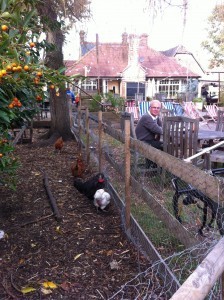
Toby sits near chooks and eats scones…
On the way back home we walked past the ruins of the Godstow nunnery. It was built on what was then an island between streams running into the River Thames. It was built in local limestone in honour of St Mary and St John the Baptist for Benedictine nuns and the church was consecrated in 1139. The Abbey was suppressed in 1539 and is now a picturesque ruin.
Today is rainy and damp and wet and miserable… Blah!
September 25, 2014
Seven go mad in Devon (and Somerset)
I’ve been away from Oxford for much of the past few weeks, on holiday in Devon/Somerset, and in Scotland with Toby for a conference and a revisit to the place we were married.
I’ve also been writing furiously (up to 35,000 words) and reading many books, because you can’t write if you don’t read. That aphorism should be emblazoned on the cover of every prospectus for a writing course. Wide reading gives you confidence, humility, inspiration and energy to work on your own project. And it’s crucial if, like me, you need to research an historical period. Unfortunately it is also rather damaging to the bank balance, but the joy of England is the easy access to second-hand books. We’ll need to send home a shipping container when we return in 2016!
Thanks to Joanna for organising our wonderful week in Somerset and Devon in early September. We stayed at Riscombe Farm, which is in the Exmoor National Park, in a cottage that used to be part of a farm building:
There were flowers everywhere and the farmhouse itself is around 200 years old. It is owned by Leonie and Brian. Leo went to school with Joanna and we were all invited to the farmhouse one afternoon for a real Somerset high tea. We reciprocated by inviting Leo and Brian to the big cottage for gin and tonic, with Karen’s amazingly tasty local Swedish gin.
Joanna whipped us into shape with walks on the moor and the coast, and the beach and the woods…
We walked up to Dunkery Beacon, the highest point in Exmoor, through the heather and bracken, eating whortleberries and blackberries along the way.
We all became adept at finding berries.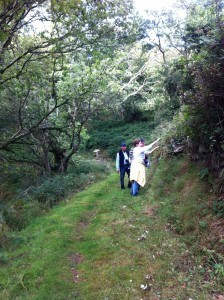
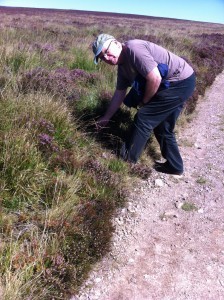
One day we visited the Tarr Steps, a Bronze Age Bridge, which local legend says was built by the Devil himself. Myth has it that he still has sunbathing rights on its stones.
Apparently, when he first built the bridge, the Devil swore to kill anyone who crossed it. A cat was sent over the Bridge to test this claim. Poor kitty was vaporised in a puff of smoke. The terrified locals approached the parson, who went himself to meet the Devil midway on the bridge. After much bad language and intimidation the Devil conceded that people might pass, except when he wants to sunbathe.
After lunch we went for a walk in the pretty woods around the river.
Another day we walked a coastal route. On the other side of the estuary is Wales: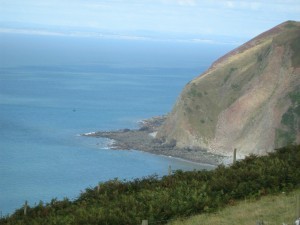
The views were lovely, but I prefer our white sands:
This is the Caratacus stone, which is thought to date from the 6th century. The inscription is translated as “grandson or immediate descendant of Caratacus” and it’s generally thought that the stone was erected as a memorial to a person who claimed the first-century British chieftain Caratacus as an ancestor.
The hedges in Exmoor are really interesting. They’re formed by bending saplings to grow horizontally: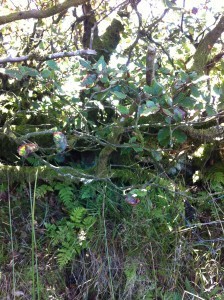
This can lead to some interesting phenomena if the ground underneath is washed away.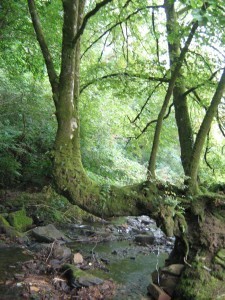
Another day we went to Lorna Doone territory. I loved that novel as a young teenager.
We even saw wild Exmoor ponies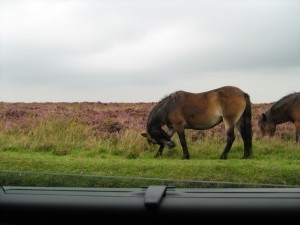
I have to say that Exmoor is amazingly beautiful and could match New Zealand for being Tolkienish. We found these weird creatures in a forest glade. The photo is untouched – the ‘eyes’ are little mushrooms.
And some of the houses were straight off the lid of a chocolate box: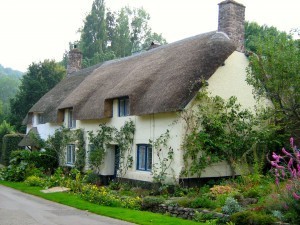
The little fishing ports were delightful. We had a pommie picnic at this one, all rugged up on an overcast day:
Next time, Scotland the Brave – Stirling and Loch Lomond.
August 25, 2014
From Stowe to Aston’s Eyot
It’s hard to settle into writing a blog. When I do the characters in my new novel (who are a jealous bunch) clamour at the back of my mind, demanding attention. Scenes of wartime London intrude as I try to describe a lovely trip to the country, there is a vague unease that I’m not hammering out that plot inconsistency instead of sharing our visit to Towerseay, or describing the smell of a bombsite in just the right way rather than the scent of our Iffley garden after rain . . .
Oh, well. . . today is cold and wet and my characters are quiet, so I’ll tell you about a few outings we’ve had lately.
On Saturday 9 August we joined our dear friends, John and Rosemary Payne for lunch at the national trust garden of Stowe, in Buckinghamshire. They are a stunning example of eighteenth century landscaping, the first project of Capability Brown. The house is now a very posh school, but the grounds belong to the National Trust.
When you arrive, you go down a very long driveway, at the end of which is a stunning Corinthian Arch. It’s designed to tell you that this is a Very Important Place.
And here are two Very Important Visitors:
We wandered around the lovely grounds – 250 acres – while I pumped John about his childhood in the Liverpool Blitz and as an evacuee child in Wales. We had lunch in the cafe, finishing with ice-cream on the lawns, while I pumped Rosemary about her childhood in outer London during the war. They’d even brought me notes of what they remembered, and items for ‘show and tell’ such as a real ration book and photos. According to Rosemary, the only fruit she saw when she was a child were apples, blackberries, plums, rasberries. She never saw an orange. she said: “Bananas: I first saw when 12/13 years old, when a girl brought one to school to show us. We gathered round and watched her peel it!”
There are various follies and temples and monuments in the grounds:
Commemorations are in full swing here for the centenary of the start of the Great War. I was very impressed by the commemoration to the Commonwealth war dead at the Tower of London: As part of the exhibition, 888,246 poppies will be ‘planted’ in the Tower of London moat this summer to represent the British and Commonwealth deaths in WW1. So I bought of the three beautiful ceramic poppies to commemorate the members of Toby’s and my families who died in the Great War.
We’ll visit the installation when we’re next in London and we’ll get our poppies in November:
http://petapixel.com/2014/08/02/breat...
Two poppies are for our great-uncles who died at Gallipoli:
(1) my great-uncle George Douglas Eastwood (my mother’s father’s brother). He was English (from the Isle of Man) but happened to be in Sydney when war broke out. He joined the First AIF and fought with the 18th Australian Infantry Battalion. He was 26 years old with he died at Gallipoli on 27 August 1915. He was shot in the water, so he never reached Anzac Cove.
(2) Toby’s great-uncle by marriage, John Thomas Clegg, of the 9th Battalion, Lancashire Fusiliers, who was killed at Gallipoli 21 August 1915, aged 40. He left a wife (Esther, nee Burrows) and eight children
(3) The third is (now) for Reginald Benton, who is Toby’s Great-uncle, his father’s mother’s brother. He died on the Western Front in October 1916 at the age of 34 (according to the Roll of Honour), and was also from the Lancashire Fusiliers. He left a wife and a son.
We decided to walk back from Oxford a different route the other day, and discovered Aston’s Eyot, formerly the municipal dump (if you’ve read Gaudy Night by Dorothy Sayers, the dump is unfavourably mentioned). The dump was closed in the 1960s. It is now a 33-acre (13 ha) nature reserve on an island partly bounded by the east bank of the River Isis (Thames). Eyot is another spelling of ait meaning small island. The island is roughly triangular, bounded to the northwest by the River Cherwell and to the southeast by the Shirelake Ditch (AKA the Cherwell Cut).
It’s part woodland, part open/scrub, and entered through Jackdaw Lane, beside the scrap metal yard. It’s delightful.
And it’s full of surprises. When it was the municipal dump unused veges and fruit of the Covered Markets would end up there, so it has apples and pear trees galore. Apparently it also has badgers and deer and other animals, protected from humans by huge swathes of nettles and thorny blackberries. This time of year it’s full of blackberriers with pans and tubs and bags, risking pain for the sweet fruit. (We were lucky enough to taste some of the spoils in a fabulous blackberry and apple pie cooked by the delightful Rebecca Banks, who had us around for dinner at her All Souls flat).
The blackberries were ripe and plentiful:
And Toby had to try them:
There are apple trees, like something out of Eden:
and sunlit glades
with enormous poplars
We went down to the banks of the Isis
and took little paths through the bushland:
and wandered into dark copses
We found the ‘Cherwell Cut’, which joins the Cherwell with the Isis (Thames),
and watched rowers enjoying a family day out.
It’s a magical part of Oxford, and so close to the city.
We were in Oxford last week and I suggested that we should look at a couple of colleges. Teddy Hall (St Edmund Hall) was open to all for free and as we looked around I remembered going to a ball there in 2001. The old church is now the library and students wander through the graveyard to get to it:
And I took a picture of the pretty gardens, with the ‘dreaming spires’ in the background.
Then it was off to Magdalen College. You’re supposed to pay 5 pounds to enter, but I mentioned to the nice boy on the desk (who happened to be Australian) that I was an Oxford graduate, from Linacre, he let us both in for free. I must have a trustworthy face, as he didn’t ask for any id.
Magdalen is one of the really outstanding colleges (even if it does charge 5 pounds, when the others only charge 2 pounds or nothing to enter). The college was founded in 1458 by William Waynflete, Bishop of Winchester and Lord Chancellor, who wanted a college on the grandest scale.
We met an angel:
This is the main quadrangle:
And an arty shot from the cloisters:
Toby thought that this was a medieval JarJar Binks (that’s a Star Wars reference, for those who have – quite rightly – refused to see Eps 1,2 and 3):
CS Lewis had rooms in this elegant building:
We visited the dining hall – very Harry Potterish (although those scenes in the movies were filmed in Christ Church dining hall, down the road):
We finished with tea in the student cafe by the Cherwell, and watched the punters:
Next . . .
Agatha Christie’s grave and Maple Durham
From Stowe to Ashton’s Eyot
It’s hard to settle into writing a blog. When I do the characters in my new novel (who are a jealous bunch) clamour at the back of my mind, demanding attention. Scenes of wartime London intrude as I try to describe a lovely trip to the country, there is a vague unease that I’m not hammering out that plot inconsistency instead of sharing our visit to Towerseay, or describing the smell of a bombsite in just the right way rather than the scent of our Iffley garden after rain . . .
Oh, well. . . today is cold and wet and my characters are quiet, so I’ll tell you about a few outings we’ve had lately.
On Saturday 9 August we joined our dear friends, John and Rosemary Payne for lunch at the national trust garden of Stowe, in Buckinghamshire. They are a stunning example of eighteenth century landscaping, the first project of Capability Brown. The house is now a very posh school, but the grounds belong to the National Trust.
When you arrive, you go down a very long driveway, at the end of which is a stunning Corinthian Arch. It’s designed to tell you that this is a Very Important Place.
And here are two Very Important Visitors:
We wandered around the lovely grounds – 250 acres – while I pumped John about his childhood in the Liverpool Blitz and as an evacuee child in Wales. We had lunch in the cafe, finishing with ice-cream on the lawns, while I pumped Rosemary about her childhood in outer London during the war. They’d even brought me notes of what they remembered, and items for ‘show and tell’ such as a real ration book and photos. According to Rosemary, the only fruit she saw when she was a child were apples, blackberries, plums, rasberries. She never saw an orange. she said: “Bananas: I first saw when 12/13 years old, when a girl brought one to school to show us. We gathered round and watched her peel it!”
There are various follies and temples and monuments in the grounds:
Commemorations are in full swing here for the centenary of the start of the Great War. I was very impressed by the commemoration to the Commonwealth war dead at the Tower of London: As part of the exhibition, 888,246 poppies will be ‘planted’ in the Tower of London moat this summer to represent the British and Commonwealth deaths in WW1. So I bought of the three beautiful ceramic poppies to commemorate the members of Toby’s and my families who died in the Great War.
We’ll visit the installation when we’re next in London and we’ll get our poppies in November:
http://petapixel.com/2014/08/02/breat...
Two poppies are for our great-uncles who died at Gallipoli:
(1) my great-uncle George Douglas Eastwood (my mother’s father’s brother). He was English (from the Isle of Man) but happened to be in Sydney when war broke out. He joined the First AIF and fought with the 18th Australian Infantry Battalion. He was 26 years old with he died at Gallipoli on 27 August 1915. He was shot in the water, so he never reached Anzac Cove.
(2) Toby’s great-uncle by marriage, John Thomas Clegg, of the 9th Battalion, Lancashire Fusiliers, who was killed at Gallipoli 21 August 1915, aged 40. He left a wife (Esther, nee Burrows) and eight children
(3) The third is (now) for Reginald Benton, who is Toby’s Great-uncle, his father’s mother’s brother. He died on the Western Front in October 1916 at the age of 34 (according to the Roll of Honour), and was also from the Lancashire Fusiliers. He left a wife and a son.
We decided to walk back from Oxford a different route the other day, and discovered Ashton’s Eyot, formerly the municipal dump (if you’ve read Gaudy Night by Dorothy Sayers, the dump is unfavourably mentioned). The dump was closed in the 1960s. It is now a 33-acre (13 ha) nature reserve on an island partly bounded by the east bank of the River Isis (Thames). Eyot is another spelling of ait meaning small island. The island is roughly triangular, bounded to the northwest by the River Cherwell and to the southeast by the Shirelake Ditch (AKA the Cherwell Cut).
It’s part woodland, part open/scrub, and entered through Jackdaw Lane, beside the scrap metal yard. It’s delightful.
And it’s full of surprises. When it was the municipal dump unused veges and fruit of the Covered Markets would end up there, so it has apples and pear trees galore. Apparently it also has badgers and deer and other animals, protected from humans by huge swathes of nettles and thorny blackberries. This time of year it’s full of blackberriers with pans and tubs and bags, risking pain for the sweet fruit. (We were lucky enough to taste some of the spoils in a fabulous blackberry and apple pie cooked by the delightful Rebecca Banks, who had us around for dinner at her All Souls flat).
The blackberries were ripe and plentiful:
And Toby had to try them:
There are apple trees, like something out of Eden:
and sunlit glades
with enormous poplars
We went down to the banks of the Isis
and took little paths through the bushland:
and wandered into dark copses
We found the ‘Cherwell Cut’, which joins the Cherwell with the Isis (Thames),
and watched rowers enjoying a family day out.
It’s a magical part of Oxford, and so close to the city.
We were in Oxford last week and I suggested that we should look at a couple of colleges. Teddy Hall (St Edmund Hall) was open to all for free and as we looked around I remembered going to a ball there in 2001. The old church is now the library and students wander through the graveyard to get to it:
And I took a picture of the pretty gardens, with the ‘dreaming spires’ in the background.
Then it was off to Magdalen College. You’re supposed to pay 5 pounds to enter, but I mentioned to the nice boy on the desk (who happened to be Australian) that I was an Oxford graduate, from Linacre, he let us both in for free. I must have a trustworthy face, as he didn’t ask for any id.
Magdalen is one of the really outstanding colleges (even if it does charge 5 pounds, when the others only charge 2 pounds or nothing to enter). The college was founded in 1458 by William Waynflete, Bishop of Winchester and Lord Chancellor, who wanted a college on the grandest scale.
We met an angel:
This is the main quadrangle:
And an arty shot from the cloisters:
Toby thought that this was a medieval JarJar Binks (that’s a Star Wars reference, for those who have – quite rightly – refused to see Eps 1,2 and 3):
CS Lewis had rooms in this elegant building:
We visited the dining hall – very Harry Potterish (although those scenes in the movies were filmed in Christ Church dining hall, down the road):
We finished with tea in the student cafe by the Cherwell, and watched the punters:
Next . . .
Agatha Christie’s grave and Maple Durham
August 13, 2014
A walk along the Isis (or is it the Thames…)
I’ve thought for a while it would be nice to include a post that showed the tow path walk along the Thames (Isis) that we take when we walk into Oxford. Most of these photos were taken not long after we arrived, in May; the walk is similar now, but there are less flowers.
The lock keeper’s pretty house, which dates from the 1920s, dominates the lock. It has a gorgeous garden, kept in order by volunteers. Now the lock is run by different shift workers, paid and volunteers, and sadly the house is their headquarters, not a home.
I love how the dog is the only one with a life-jacket, and I love the name of the narrowboat:
The geese at the lock are still a major feature, and you don’t get between them and the goslings:
A little way past the lock is a really lovely bridge across the slipway.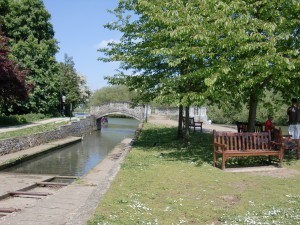
Then we (usually) walk past the Isis Tavern, dating from the 1840s and open on weekends. You can’t drive to it and access is only on foot, bike or boat! It is a fantastic place, with good food and beer (and cake!)
Next to the Tavern is an large meadow. I love this photo, which could date from any time: the child and its mother walking through the long grass in the meadow, towards the river.
Is it the river Isis or the river Thames?
As Wikipedia says: The Isis is the name given to the part of the River Thames above Iffley Lock which flows through the university city of Oxford, England, past Christ Church Meadow and the focal point of rowing for Oxford University.
Historically, and especially in Victorian times, gazetteers and cartographers insisted that the river Thames was correctly named the River Isis from its source until Dorchester-on-Thames, where the river meets the River Thame and becomes the “Thame-isis” (from which the Latin, or pre-Roman Celtic, name Tamesis is derived), subsequently abbreviated to Thames; current Ordnance Survey maps still label the Thames as “River Thames or Isis” until Dorchester. Since the early 20th century this distinction has been lost in common usage even in Oxford, and some historians suggest the name Isis is nothing more than part of Tamesis, the Latin name for the Thames.
Whatever the name, it’s lovely to look at or to sunbathe beside:
It’s a magnet for narrow boats, which moor along the river.
And for the rowers and scullers – and bicycles:
Further along the path is Dorrington Bridge. Its rather obscure graffiti has been there since my Oxford days in 2000, it reads: ‘Hanu is God’.
We love the large meadow past the bridge, in which horses graze alongside geese. Toby swears that they’re gypsy horses.
In spring the towpath was lined with lilac blossom.
A little further along the path takes us past a very large boatshed, which is shared by several colleges:
Once, it was open and we had a look around:
A little further the path the older College boatsheds are visible on the other side of the river. They stand where the Cherwell and the Isis meet:
The Cherwell (pronounced Charwell) is the main punting river in Oxford.
The river can get rather crowded there:
But the route takes us past a peaceful brook off to the side:
Now we’re getting closer to Oxford and it’s a bit more crowded and a bit less salubrious.
A prize if you can find the little white dog in this photo.
Close to the end of the path is Oxford’s answer to a Venetian mansion.
And then, it’s the Head of the River pub:
Beyond the pub is one of the sights of Oxford, the rather creepy Statue House on the river:
And now we’re in Oxford. It’s just a short walk up St Aldates past Christ Church to Carfax, the centre of town.
Next time – Beautiful Stowe gardens, Magdalen College and more…
July 26, 2014
Dorchester chronicles
Happy Birthday, Nige!! It’s my handsome, smart, savvy and altogether gorgeous step-son’s birthday.
It’s been a quiet couple of weeks, although we made a point of doing a bit of sightseeing. It’s such lovely weather that we’ve got to get outside. Otherwise we spend all day in front of our respective computers – Toby downstairs and me upstairs, Toby working on his project and me writing, with a break to eat lunch in the garden.
On Thursday the week before last we went into Oxford and attended a free daytime concert at the Ashmolean Museum. It featured a baroque cello and an original harpsichord from the museum. The cello was played by an Australian friend of our next-door neighbour Venetia, who is originally from Melbourne. It was a very elegant room and the music was delightful, and included Bach partitas.
We had afternoon tea at the museum and then walked home via the Turf Tavern, which looked lovely with its baskets of flowers:
Last Sunday we went for a drive in the country, to the lovely village of Dorchester. It is a largely unspoilt old village, as they built a bypass in the 1980s, which keeps out most of the traffic. As with many of the villages around here, there are some thatched cottages and lots of flowers.
The village has the claim to fame of being in more than a few episodes of Midsomer Murders. In medieval times it was an important trading centre and had an Abbey. Now all that is left is the imposing church, which has a very impressive lych gate. It was saved from destruction at the time of the dissolution of the monasteries by the local lord of the manor. He, very sensibly, bought the church and gave it back to the village.
We saw the local Vicar outside the church and asked her where would be a good place to eat lunch. She was diplomatic and said that she shouldn’t play favourites, but then a shifty look came over her face and she said quickly (after a glance around) that the Fleur makes its gravy out of stock made from bones, “the way it should be done”.
We took the hint and it was one of the best roast dinners I’ve ever eaten. The gigantic Yorkshire Pudding (to share) came on its own plate, there were lashings of gravy, mustard mashed potato, cauliflower cheese, crisp roast potatoes and home-made horseradish. Not surprisingly, the Fleur was also used in an episode of Midsomer Murders.
After lunch we walked across the fields to Day’s Lock on the Thames – from where you can look up to the hills of Wittenham Clumps, which we’d climbed a few weeks before.
We saw poppies in the wheatfield, which were lovely:
We next spent some time in the local history museum, which, along with the tea-room is located in the 14th century former Abbey guest house. After learning that the area is one of earliest occupied in the country and boasted a Villa in Roman times, we had to try the home home-made cake for afternoon tea. The Abbey guest-house also featured in an episode of Midsomer Murders (of course!). It was the one when Joyce joins the local historical society. I can’t remember which Midsomer village Dorchester was supposed to be in that episode: Midsomer Parva, or was it Midsomer Mallow, maybe Midsomer Wyvern. Couldn’t have been Badgers’ Drift…
On the way home from Dorchester we stopped by another little village, Sutton Courtenay. It’s where George Orwell is buried under his real name of Eric Arthur Blair. He had no connection with the village, but his publisher asked the local vicar if he could be buried in a spare plot in the churchyard, and the vicar agreed. It’s a lovely, peaceful spot.
This may look like an unknown entry to Moria, but it’s actually a Norman doorway into the church:
In the bright midsummer here in Oxfordshire we have lots of lovely flowers.
The jasmine outside the back door releases its heavy scent night and day and we’ve seen real bumble-bees, enormous things that tumble around the blossom. Toby even mowed the lawn yesterday – it grows three centimetres in a week – but it’s soft and springy and only around 15 minutes work with the electric hover mower. He doesn’t even break a sweat.
This week’s highlight was a visit to Kelmscott Manor, the former house of William Morris on the upper Thames. When we went there last time the house wasn’t open. It was worth the wait, though, as it’s in much the same state as when Morris died over a hundred years ago. It’s full of beautiful and interesting furniture, artefacts and books – as well as Morris’s woollen overcoat! The gardens were lovely.
Anyone for croquet?
Toby surreptitiously picked and ate an apple in the orchard. Here’s a photo of the Apple Thief:
One unusual feature was the three-seater privy (outdoor toilet) in a shed at the back. For practically the whole time the Morris family was there, this was the only toilet:
Kelmscott is close to the Thames. We walked down there, to a lonely stretch of the river looking pretty in the glorious sunshine.
And on the way we passed a somewhat incongruous World War II concrete bunker lurking in the trees on the bank. There are hundreds of these all over Britain. Apparently the Thames was going to be a line of defence for the Home Guard in the expected German invasion. But what about those pesky paratroopers, Cap’n Mainwaring?
We’re still getting used to this island weather. It’s been hot in the past couple of weeks, and the weather man said that a storm was on its way last Saturday.
Storm clouds brooded overhead for most of the day, but no rain. Toby was sitting in the back yard with his book and I came out and said, ‘was that a drop of rain?’ Then the heavens unleashed! Thunder. Lightening. A good four inches of rain. Hail. It all lasted about twenty minutes and then the clouds rolled away and we saw a little sunshine.
The same thing happened in London yesterday. It was heavy humid weather. We were sitting outside a lovely cafe in the gorgeously named Lamb’s Conduit Street in Bloomsbury. I said, ‘Is that a drop of rain?” And it happened again – thunder, lightening, torrents of rain. Then peace.
I’m writing steadily and doing a lot of research. I love it here, but for the first time, on the bus back from London yesterday, I had a bout of homesickness. Maybe it’s watching the Commoonwealth Games, but I missed Perth. It passed…

